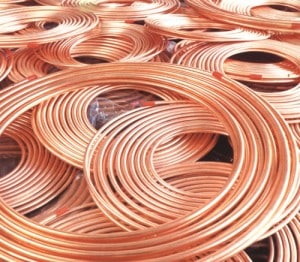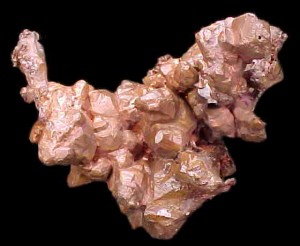Copper is a mineral. It is not a plant or an animal. Copper is a metallic metal. It can never be broken down into different substances  by normal chemical means. Copper was one of the first metals known to humans. People liked it because in its native condition, it could easily be beaten into weapons or tools. Copper has been one of the most useful metals for over 5000 years. Copper was probably used around 8000 B.C by people living along the Tigris and Euphrates rivers. In 6000 B.C, Egyptians learned how to hammer copper into things they wanted. Around 3500 B.C, People first learned how to melt copper with tin to make bronze. So the period between 3000 B.C and 1100 B.C became known as the Bronze Age.
by normal chemical means. Copper was one of the first metals known to humans. People liked it because in its native condition, it could easily be beaten into weapons or tools. Copper has been one of the most useful metals for over 5000 years. Copper was probably used around 8000 B.C by people living along the Tigris and Euphrates rivers. In 6000 B.C, Egyptians learned how to hammer copper into things they wanted. Around 3500 B.C, People first learned how to melt copper with tin to make bronze. So the period between 3000 B.C and 1100 B.C became known as the Bronze Age.
Today, some of the leading states of the copper industry are Arizona with 747,000 short tons, Utah with 187,000 short tons, New Mexico with 161,000 short tons. Some other leading countries are Chile with 1,422,000 short tons, United States with 1,203,000 short tons, Soviet Union with 650,000 short tons, and Zambia with 596,000 short tons. When copper is being mined, both Native copper and copper ore are usually found. The highest grade of copper ore is pale silvery gray. Miners used to be always in danger in copper mines. Today, we have reduced a fair amount of these hazards. Miners wear hats made of iron or very hard plastic. This is to protect them from falling rocks. Lamps are also attached to these helmets in case some of the lighting in the mine goes out leaving a miner stranded in the dark. One of the biggest problems with mining is that in some places dangerous gases may exist, like Carbon Monoxide. In the past we had very cruel and inhuman ways to detect harmful gases. One of these ways was the use of canaries. Miners would let them fly into a part of the mine where a poison gas was suspected.
If there was a harmful gas, the bird would fall over dead at the first scent of the gas. Today, we have better ways to detect gases without having animals die. We now have detection machines in all parts of mines. Mines also have top of the line fire alarms and  water systems. If a flammable gas ignites, like sulfur, the fire may not die for years, which results in closing the mine. Another problem miners complain about are the rats. Mines will often have mine cats that hunt out the rats. These cats are well fed and petted by most of the miners. Most copper is found in seven ores. That means it’s mixed in with other metals like lead, zinc, gold, cobalt, bismuth, platinum, and nickel. These ores will usually have only about 4% pure copper in them though. Sometimes miners may only find 2%. The things that make copper such a popular metal are malleability which is how easily it bends. Copper is highly malleable and won’t crack when hammered or stamped. Ductility is also a good property and is the ability to be molded or bent into a shape. Copper can be pulled into very thin wire. For example, if you took a copper bar, 4 inches (10 centimeters) square, you could draw it into wire thinner than a human hair. One of the most amazing things about copper is its resistance to corrosion.
water systems. If a flammable gas ignites, like sulfur, the fire may not die for years, which results in closing the mine. Another problem miners complain about are the rats. Mines will often have mine cats that hunt out the rats. These cats are well fed and petted by most of the miners. Most copper is found in seven ores. That means it’s mixed in with other metals like lead, zinc, gold, cobalt, bismuth, platinum, and nickel. These ores will usually have only about 4% pure copper in them though. Sometimes miners may only find 2%. The things that make copper such a popular metal are malleability which is how easily it bends. Copper is highly malleable and won’t crack when hammered or stamped. Ductility is also a good property and is the ability to be molded or bent into a shape. Copper can be pulled into very thin wire. For example, if you took a copper bar, 4 inches (10 centimeters) square, you could draw it into wire thinner than a human hair. One of the most amazing things about copper is its resistance to corrosion.
Copper will not rust. However, when the air grows damp, copper will go from reddish-orange to reddish brown. After being in damp air for long periods of time, a green film will coat the copper, called patina, which will protect it from further corrosion. Since copper is one of the most widely used metals in the world we use it for a lot of things. Copper gives us water heaters, boilers and cooking utensils. It is used for outdoor power lines, cables, lamp cords, and house wiring. Electrical machinery like generators, motors, controllers, signaling devices, electro magnets, and communication devices all use copper.
